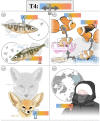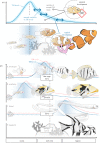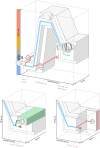The ecological function of thyroid hormones
- PMID: 38310932
- PMCID: PMC10838650
- DOI: 10.1098/rstb.2022.0511
The ecological function of thyroid hormones
Abstract
Thyroid hormones (TH) are central hormonal regulators, orchestrating gene expression and complex biological processes vital for growth and reproduction in variable environments by triggering specific developmental processes in response to external cues. TH serve distinct roles in different species: inducing metamorphosis in amphibians or teleost fishes, governing metabolic processes in mammals, and acting as effectors of seasonality. These multifaceted roles raise questions about the underlying mechanisms of TH action. Recent evidence suggests a shared ecological role of TH across vertebrates, potentially extending to a significant portion of bilaterian species. According to this model, TH ensure that ontogenetic transitions align with environmental conditions, particularly in terms of energy expenditure, helping animals to match their ontogenetic transition with available resources. This alignment spans post-embryonic developmental transitions common to all vertebrates and more subtle adjustments during seasonal changes. The underlying logic of TH function is to synchronize transitions with the environment. This review briefly outlines the fundamental mechanisms of thyroid signalling and shows various ways in which animals use this hormonal system in natural environments. Lastly, we propose a model linking TH signalling, environmental conditions, ontogenetic trajectory and metabolism. This article is part of the theme issue 'Endocrine responses to environmental variation: conceptual approaches and recent developments'.
Keywords: adaptation; ecology; hormone function; thyroid hormones.
Conflict of interest statement
We declare we have no competing interests.
Figures




References
Publication types
MeSH terms
Substances
LinkOut - more resources
Full Text Sources
